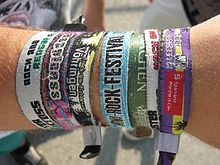Control bracelet
A control wristband (also known as an admission wristband ) consists of a thin strip of plastic, textiles or paper that is attached to the wrist. It is an often used means of identification, especially at events. The respective authorization is evident from its colors and imprints. In order to prevent multiple use or transfer, it is designed and attached so that it cannot be removed without being destroyed. In its simplest form it is used for optical access control, for extended applications it can also be equipped with NFC or RFID .
plastic
Plastic bracelets are usually about 2 centimeters wide strips of vinyl , Tyvek , tri-laminates , silicone or other plastics that are placed around the arm and fastened with a special clasp. A knob is pushed through an eyelet at the other end and through another locking eyelet. The eyelet clamps the knobs in such a way that the tape can no longer be opened without cutting it. They are particularly suitable when using chips or other technical equipment, as they offer the necessary stability and protection against the effects of water. Depending on the design, they are more or less comfortable to wear.
paper
A strip of paper is placed around the arm and closed on itself with the help of an adhesive surface. The adhesive surface is punched in such a way that it cannot be removed or can only be removed with great difficulty. The paper is usually reinforced by a fabric. In contrast to straps made of fabric and plastic, paper wristbands are very inexpensive, but very susceptible to water and other mechanical influences. Therefore, they are usually only used if the tape can be removed again after a day.
textiles
At events lasting several days, such as music festivals , control straps made of textile are often used for reasons of wearing comfort. The term festival ribbon is often used synonymously among visitors. The band is closed, sewn or welded with an aluminum or plastic sleeve. In the aluminum version, a thin sleeve is slipped over the two ends of the ribbon that have been joined together and pressed together using special pliers. The aluminum sleeve can, however, be pried open again using a screwdriver or similar object, which enables the ribbon to be removed and reattached. In the case of plastic closures, a plastic sleeve equipped with barbs is slipped over the two ends . If you pull the sleeve towards the arm, the loop around the arm becomes smaller and is secured by the barbs. It is not possible to open the loop without destroying the fastener or the ribbon. Since 2011, Rock am Ring has used a method in which the ends of the ribbon are brought together and tightened around the visitor's arm with a certain amount of play. Then the two ends are welded by applying heat and pressure. Sewing the ends is also common at some festivals.
Festival ribbons often serve as a status symbol among festival visitors. The more ribbons a fan wears, the more concerts and festivals he inevitably has to visit. Some fans therefore wear so many ribbons on both arms that both forearms are completely covered with fabric.
UV wristbands
UV Ultra Violet Sensitive silicone wristbands appear clear / white when they are not exposed to UV light. The UV bracelets are personalized for every skin tone - an important feature as dark people need more sun exposure to produce vitamin D , which is essential for healthy bones, teeth and muscles.
See also
Web links
Individual evidence
- ↑ Premiere: The Hurricane Festival 2012 introduces preliminary festival wristbands, Musikexpress.de, accessed on September 3, 2013
- ↑ The festival wristband is no longer sealed and is wider , Rock-am-Ring blog, accessed on August 23, 2015
- ↑ New wristband provides personalized and real-time tracking of UV exposure. Retrieved October 21, 2019 .

